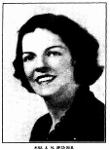The author, Mrs. Jean Spender, wife of Mr. P. C. Spender, of the New South Wales Bar, has evidently brought to her work a first-hand knowledge of social life in Sydney and of life at the homestead of one of the big stations in New South Wales. Her closely knit story presents a set of characters so well drawn, and a series of incidents that succeed each other so naturally, that the interest of the reader is gripped at the outset and is closely held up to the end. There is no unnecessary introductory matter. The story begins with the first line, and moves forward uninterruptedly to the last page, amid scenes both of city life and of country life that are not only thoroughly Australian, but are portrayed with descriptive touches that give new freshness and vividness to themes that have often been handled before, and yet must always make a warm appeal to Australian readers. In the first part of this tale the reader meets a frank, delightful young Australian whose business interests are administered by an older professional man, who holds his power of attorney, and who, by misuse of that authority, is able to rob his unsuspecting friend and client of a large fortune. In these chapters the author has shown how a clever scoundrel may dig a terrible pitfall for an innocent man, not only by robbing him of a fortune, but also getting him convicted and sentenced to a long term of imprisonment for a crime committed by the plotter himself. Released at last from prison, Michael Tregarth is next discovered "doing a perisher" while looking for work on a station in drought time. He is rescued in the nick of time by Elizabeth, who is part owner of the station with her brother. Michael and Elizabeth become the principals in a finely told love story, in the course of which the false friend who betrayed Michael's trust years before appears again as his rival in love. It is through the courage and devotion of Elizabeth that the plots of the villain are checkmated in the course of an exciting duel of wits which takes place amid Sydney scenes again. There is plenty of brisk adventure in the narrative. A furious rough-and-tumble Fix this textfight in a fashionable Sydney suburban home provides a thrilling climax that leads up to the moment when "All's well that ends well." A warm appreciation of the natural beauty of Sydney and its surroundings and of the simple joys and wholesome amusements of station life on one of the fine old grazing properties of the interior of this State may be felt in the well-written descriptive passages of this story, which gives a realistic portrayal, on modern lines, of present-day life—shorn only of its present and possibly temporary conditions—in New South Wales.
"Our New Serial", The Sydney Morning Herald, 21 October 1931, p7.
 7657447256975928823.jpg
7657447256975928823.jpg